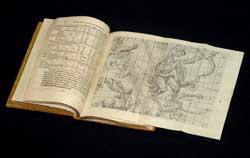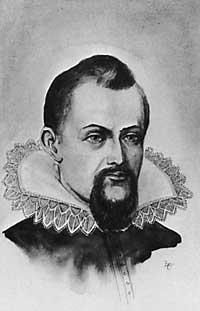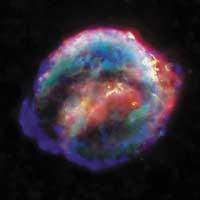Stars and stars
2008/12/10 Carton Virto, Eider - Elhuyar Zientzia

It is very poetic to think that a death triggered an important stage of astronomical advances. In fact, on November night no star was born and it did not go out two years later. The phenomenon that appeared in the sky in November 1572 was a supernova, a gigantic explosion of a star, although with that name it is not XX. Describe until the mid-twentieth century. It was so spectacular that many astronomers from all over the world observed it and studied it with the tools at their disposal at that time (while the telescope was about to be discovered), but above all, the supernova is linked to the name of Tycho Brahe, until it came to say the supernova of Tycho Brahe.
The Danish astronomer described in the book De Stella Nova, published in 1573, the best and most accurate, which made extremely precise measurements, and stated that the star should be much further than the Moon, impossible according to the prevailing Aristotelian vision. Today we know that it is 7,500 light-years from Earth and that it has not completely disappeared. The news took place last week, as Brahe's heirs have been able, through powerful modern telescopes, to capture and measure the echo of that spectacular explosion that over four hundred years ago was seen at first sight. Thanks to this measurement, a group of researchers from the Max Planck Institute of Astronomy have determined what kind of supernova it was, and have given us the perfect excuse to remember old times.

History says that the 1572 supernovel was decisive in fully linking Brahe to astronomy, and Brahe's work was fundamental for Kepler to develop the three basic laws on the movement of planets. Kepler had just been born when Tycho's supernova exploded, but the two astronomers had the opportunity to work together in a very short term: just two years. Brah invites Kepler to work at his Prague observatory in 1600, but the relationship between the two was not very good. Brah did not give Kepler the freedom to copy and use his data, he placed great limitations on it. Brahe died unexpectedly in October 1601 and Kepler 'received' his job and measurements.
It is not entirely clear whether he saved or stole Brahe's data from his heir treasuries, although most sources support the second hypothesis. The truth is that they ended up in the hands of Kepler and that from the analysis of those data - from the data of Mart- Kepler concluded especially the three basic laws on the movement of the planets. The master was inspired by the death of a celestial body and nourished by the death of that earthly body. One star, two stars, three...
Published in Berria

Gai honi buruzko eduki gehiago
Elhuyarrek garatutako teknologia





